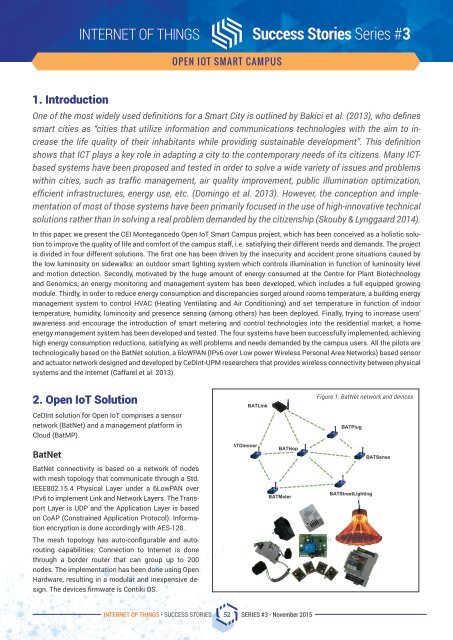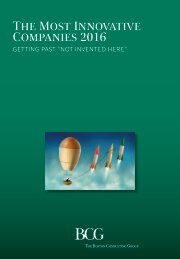Success Stories
VEZSJ
VEZSJ
Create successful ePaper yourself
Turn your PDF publications into a flip-book with our unique Google optimized e-Paper software.
Internet of Things <strong>Success</strong> <strong>Stories</strong> Series #3<br />
Open IoT Smart Campus<br />
1. Introduction<br />
One of the most widely used definitions for a Smart City is outlined by Bakici et al. (2013), who defines<br />
smart cities as “cities that utilize information and communications technologies with the aim to increase<br />
the life quality of their inhabitants while providing sustainable development”. This definition<br />
shows that ICT plays a key role in adapting a city to the contemporary needs of its citizens. Many ICTbased<br />
systems have been proposed and tested in order to solve a wide variety of issues and problems<br />
within cities, such as traffic management, air quality improvement, public illumination optimization,<br />
efficient infrastructures, energy use, etc. (Domingo et al. 2013). However, the conception and implementation<br />
of most of those systems have been primarily focused in the use of high-innovative technical<br />
solutions rather than in solving a real problem demanded by the citizenship (Skouby & Lynggaard 2014).<br />
In this paper, we present the CEI Montegancedo Open IoT Smart Campus project, which has been conceived as a holistic solution<br />
to improve the quality of life and comfort of the campus staff, i.e. satisfying their different needs and demands. The project<br />
is divided in four different solutions. The first one has been driven by the insecurity and accident prone situations caused by<br />
the low luminosity on sidewalks: an outdoor smart lighting system which controls illumination in function of luminosity level<br />
and motion detection. Secondly, motivated by the huge amount of energy consumed at the Centre for Plant Biotechnology<br />
and Genomics, an energy monitoring and management system has been developed, which includes a full equipped growing<br />
module. Thirdly, in order to reduce energy consumption and discrepancies surged around rooms temperature, a building energy<br />
management system to control HVAC (Heating Ventilating and Air Conditioning) and set temperature in function of indoor<br />
temperature, humidity, luminosity and presence sensing (among others) has been deployed. Finally, trying to increase users’<br />
awareness and encourage the introduction of smart metering and control technologies into the residential market, a home<br />
energy management system has been developed and tested. The four systems have been successfully implemented, achieving<br />
high energy consumption reductions, satisfying as well problems and needs demanded by the campus users. All the pilots are<br />
technologically based on the BatNet solution, a 6loWPAN (IPv6 over Low power Wireless Personal Area Networks) based sensor<br />
and actuator network designed and developed by CeDInt-UPM researchers that provides wireless connectivity between physical<br />
systems and the internet (Caffarel et al. 2013).<br />
2. Open IoT Solution<br />
CeDInt solution for Open IoT comprises a sensor<br />
network (BatNet) and a management platform in<br />
Cloud (BatMP).<br />
BatNet<br />
BatNet connectivity is based on a network of nodes<br />
with mesh topology that communicate through a Std.<br />
IEEE802.15.4 Physical Layer under a 6LowPAN over<br />
IPv6 to implement Link and Network Layers. The Transport<br />
Layer is UDP and the Application Layer is based<br />
on CoAP (Constrained Application Protocol). Information<br />
encryption is done accordingly with AES-128.<br />
The mesh topology has auto-configurable and autorouting<br />
capabilities. Connection to Internet is done<br />
through a border router that can group up to 200<br />
nodes. The implementation has been done using Open<br />
Hardware, resulting in a modular and inexpensive design.<br />
The devices firmware is Contiki OS.<br />
BATLink<br />
BATDimmer<br />
BATHop<br />
BATMeter<br />
Figure 1. BatNet network and devices<br />
BATPlug<br />
BATSense<br />
BATStreetLighting<br />
Internet of Things • <strong>Success</strong> <strong>Stories</strong> 52 SERIES #3 - November 2015









